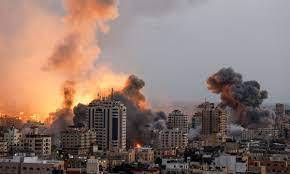
From The New York Times' humanitarian focus to The Guardian's detailed event coverage, Democracy Now's personal interview, and Al Jazeera's analysis of checkpoints, various journalistic pieces paint a comprehensive picture of the Gaza crisis and provide a well-rounded understanding of the crisis, albeit sometimes with potential biases of their respective outlets.
The New York Times article presents a harrowing picture of the situation in northern Gaza, where Palestinian civilians are being compelled to leave their homes due to the looming threat of an Israeli ground invasion. It describes how the southern region, where many are relocating, is already grappling with resource shortages and the aftermath of a week of Israeli airstrikes, which have damaged transportation routes. The tragic consequence of these circumstances is highlighted as the article reports on airstrikes killing Palestinians who were trying to flee northern Gaza on the highway.
The involvement of aid groups and the United Nations in condemning the Israeli evacuation order as illegal under international law is extensively covered, underscoring the gravity of the situation. The article emphasizes the palpable fear of a looming humanitarian catastrophe and the desperate need for negotiations to establish a humanitarian channel for essential aid to reach the affected population. It provides a detailed account of the deadly Israeli airstrikes that have severely affected Gaza, causing a surge in casualties and overwhelming the medical system. The human cost of the conflict is portrayed through the rising number of casualties, contributing to the article's somber tone and call for immediate international intervention.
Additionally, the article touches on the global response to the crisis, such as protests in the Middle East, calls for international demonstrations by Hamas, and diplomatic efforts to ensure the safe passage of American citizens and foreigners out of Gaza. The engagement of U.S. officials and their meetings with regional leaders reflects the urgency and complexity of the situation.
The Guardian article, in stark contrast, zooms in on a particular event: the sudden breach of the Gaza-Israel barrier by Hamas militants during the Sukkot holiday. It provides a vivid description of the audacious actions taken by these militants, including the use of explosive devices dropped from drones to disable communication towers and remote-controlled machine gun posts. Subsequently, Hamas fighters infiltrated through these openings. The article highlights the chaos and lack of preparedness on the part of Israeli defenders, who were unable to respond effectively.
The article offers a detailed account of the daring and coordinated actions of Hamas militants, who used various tools, from wire cutters to motorized paragliders, to infiltrate Israeli territory. It delves into the motives behind these actions, attributing them to a desire to capture hostages for negotiation and to challenge what Hamas perceives as Israeli occupation. Human cost is a central theme, and the article goes into great detail about the tragic loss of life, hostage-taking, and the overrunning of military bases and kibbutzim near the Gaza border. Chilling testimonies from survivors and witnesses are included, adding depth to the narrative and emphasizing the brutal nature of the attack.
The article also discusses the failures of Israeli intelligence and security in adequately preparing for such an attack, despite some warning signs and indicators. This miscalculation and lack of preparedness had severe consequences for Israeli soldiers and civilians.
The Democracy Now interview with Muhammad Shehada offers a personal account of the dire situation in Gaza. Shehada, speaking from Copenhagen, describes the widespread destruction and suffering, emphasizing that this surpasses anything he has seen in his lifetime or in Gaza's history. The ongoing Israeli airstrikes and shelling have caused massive damage to infrastructure, making evacuation extremely challenging and dangerous. Shehada highlights the international community's complicity in Israel's actions, as some governments have not adequately addressed or condemned the situation. The interview underscores how European and U.S. officials have not pressured Israel to change its course of action, and it sheds light on the slow reporting by mainstream media on certain aspects of the crisis, such as the use of prohibited weapons by Israel.
The interview concludes by sharing the voices and concerns of Palestinians in Gaza, who face extreme fear and uncertainty with seemingly no one willing to intervene to stop the ongoing violence and suffering. Overall, it underscores the gravity of the crisis and the need for greater international attention and action to address the situation.
The Al Jazeera article explores the extensive network of military checkpoints in the occupied West Bank, highlighting their impact on the daily lives of Palestinians. It suggests a connection between recent Hamas attacks on southern Israel and unchecked violence initiated by Israeli settlers in the West Bank. This includes "hit and burn" attacks against Palestinians and their properties, often without intervention from the Israeli military.
The article further raises questions about whether the Israeli government has turned a blind eye to settler aggression or tacitly encouraged it, with the goal of protecting Israeli settlers from potential attacks. It notes that the checkpoints are primarily located along the separation barrier, a wall that stretches over 700 kilometers through Palestinian lands, effectively isolating the West Bank from Israel. The existence of these barriers has made daily life difficult and complicated for the Palestinian population.
The article suggests that the checkpoints and the security of settlements require significant manpower, which poses a challenge in deploying all available forces for an expected Gaza invasion within a specific timeframe. This logistical consideration is a key element of the article's content.
These journalistic insights serve as a reminder that while the media can shape our perception of global events, it is ultimately up to individuals to critically engage with and interpret the narratives that are presented to them. The Gaza crisis is far from a one-dimensional issue, and its resolution requires a nuanced understanding, compassion, and global attention.

